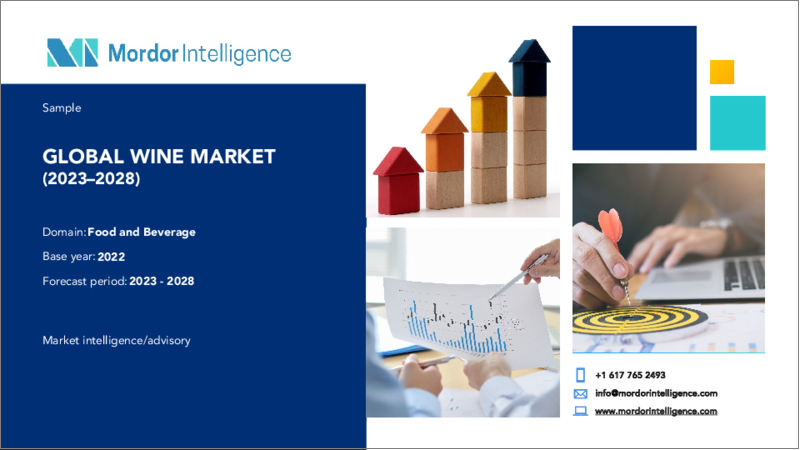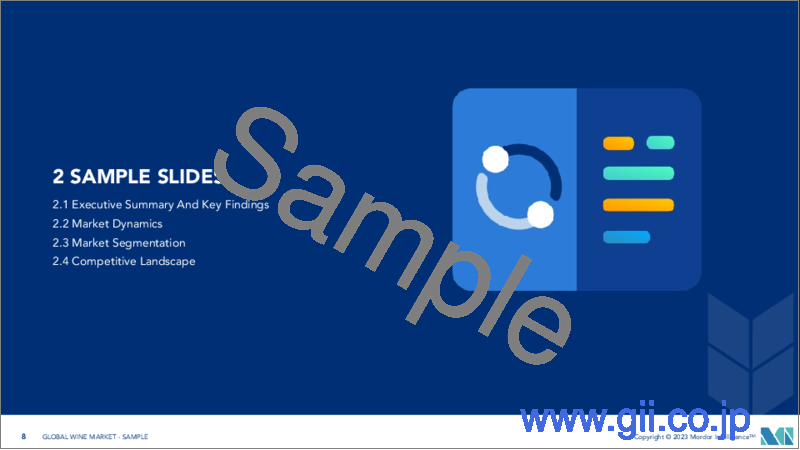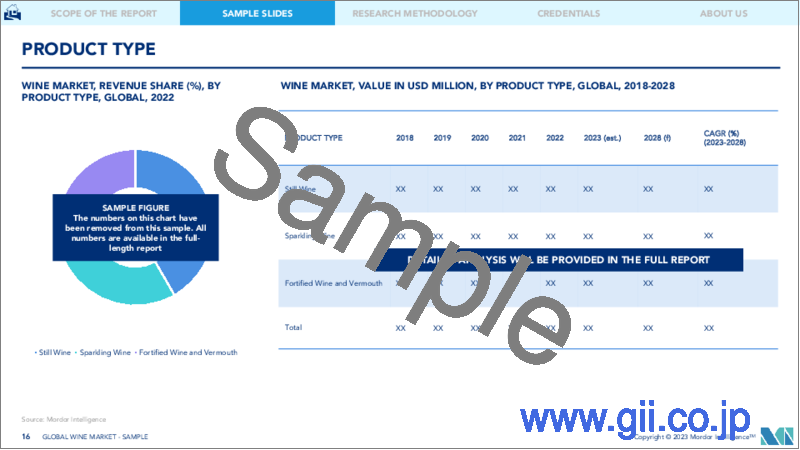|
|
市場調査レポート
商品コード
1198816
ワイン市場- 成長、動向、予測(2023年~2028年)Wine Market - Growth, Trends, and Forecasts (2023 - 2028) |
||||||
|
● お客様のご希望に応じて、既存データの加工や未掲載情報(例:国別セグメント)の追加などの対応が可能です。 詳細はお問い合わせください。 |
|||||||
| ワイン市場- 成長、動向、予測(2023年~2028年) |
|
出版日: 2023年01月23日
発行: Mordor Intelligence
ページ情報: 英文 156 Pages
納期: 2~3営業日
|
- 全表示
- 概要
- 目次
ワイン市場は、今後5年間でCAGR4.28%を記録すると予測されています。
COVID-19の大流行は、米国、英国、インドなどさまざまな国で、ウイルスの蔓延を抑えるためにオン・トレードのワイナリーが強制的に閉鎖されたため、ワイン業界に大きな影響を及ぼしました。しかし、現在の状況は、ワイン業界が失われた消費者の関心を取り戻すことを可能にするかもしれません。分析によると、欧米諸国を中心に、家庭での食事と一緒に楽しむためにワインを購入する人が増えているため、ワインの総量は前年比で増加しているとのことです。一方、パントリーが枯渇し、オン・トレードが徐々に再開され、消費行動がCOVID-19以前のレベルに戻った後、市場とオフ・トレードにおける現在のブームが続くかどうかは不透明です。
ワイン市場は、健康上の利点やワイン製品のプレミアム化による需要の増加、フレーバーの革新や世界の流通網の高度化によって牽引されると思われます。米国やカナダにおける大麻の合法化など、政府の政策と新たな規制により、ワインに新たなフレーバーが注入され、消費者の注目を集めています。消費者の嗜好の変化や新しい嗜好、そしてリースリングワインやその他のトロピカルフルーツワインなど、新しいエキゾチックなフレーバーに対する需要の増加が、今後のワイン市場の成長を促進すると予想されます。市場プレイヤーは、より良い市場シェアのために買収を形成しています。例えば、2022年10月、Pernord RicardはSovereign Brandsとの提携を発表し、高級ワインとスピリッツのポートフォイロを強化することを発表しています
ワイン市場の動向
酒精強化ワインやその他の高級食材を使用したワインへの需要の急増
製品のプレミアム化は、今後数年間、酒精強化ワイン市場の成長を促進すると予想される主要な要因の1つです。新興国市場の大手企業は、消費者の嗜好の変化に対応するため、新しい風味の酒精強化ワインの開発に注力しています。マリファナ入りのワインは、特に米国などの市場で高い人気を集めています。これはおそらく、世界のアルコール飲料市場に影響を与える最も重要な動向です。世界の市場では、主に幅広いカテゴリーにおいて、消費者がより高価値の製品にシフトしていることが確認されています。この傾向は、米国のような新興国市場で顕著に見られます。消費者は、ユニークで興味深いアルコール飲料を探求することに熱心です。
アジア太平洋と南米でワイン消費量が急増
アジア太平洋地域はワインの需要をリードしており、中でも中国が市場を独占しています。特に、中国では赤い色が縁起が良いとされているため、伝統的に赤ワインの消費が目立ちます。したがって、中国は赤ワインの主要市場の1つであり、フランスやイタリアと厳しい競争をしています。アジア太平洋地域におけるワインの消費量は、オーストラリアが第2位、次いで日本となっています。また、インドはワインの消費量が最も伸びている国で、約7%の成長率を記録しています。フィリピン、韓国、ベトナムは、アジア太平洋におけるその他の潜在的なワイン消費市場です。香港にはワインの輸入税がなく、これが市場の促進要因となっています。ブラジルとアルゼンチンも、ワイン市場の将来的な成長見通しを反映する重要な国です。この2カ国は、中間層の拡大や、特にブラジルでワイン消費文化の促進を目指すExpand ImportadoraやInterfood Importacaoといった大手輸入業者によるマーケティングキャンペーンが主な要因です。
ワイン市場の競合他社分析
ワイン市場は、多くの世界企業や国内企業が各国で事業を展開しているため、競争が激しい市場です。著名な企業としては、E. &J. Gallo Winery、Constellation Brands Inc.、The Wine Group LLCなどが挙げられます。これらの企業は、ワインの価格帯を幅広く設定しているため、市場で大きなシェアを獲得しています。どの地域にも強固な流通経路を持つ国内企業が複数存在するため、より高い市場シェアを求める世界企業はそれらの企業を好んで買収しています。また、製品の差別化は消費者層の拡大につながるため、企業は新製品開発をもう一つの主な戦略として採用しています。
その他の特典
- エクセル形式の市場予測(ME)シート
- アナリストによる3ヶ月間のサポート
目次
第1章 イントロダクション
- 調査の成果 および調査前提条件
- 本調査の対象範囲
第2章 調査手法
第3章 エグゼクティブサマリー
第4章 市場力学
- 市場促進要因
- 市場抑制要因
- 産業の魅力- ポーターのファイブフォース分析
- 新規参入業者の脅威
- 買い手/消費者の交渉力
- 供給企業の交渉力
- 代替品の脅威
- 競争企業間の敵対関係
第5章 市場セグメンテーション
- 製品タイプ
- スティルワイン
- スパークリングワイン
- 酒精強化ワインとベルモット
- 色
- 赤ワイン
- ロゼワイン
- 白ワイン
- 販売チャネル
- スーパーマーケット/ハイパーマーケット
- 専門店
- オンラインショップ
- その他の流通チャネル
- 地域別
- 北米
- 米国
- カナダ
- メキシコ
- その他北米地域
- 欧州
- ドイツ
- 英国
- スペイン
- フランス
- イタリア
- ロシア
- その他の欧州地域
- アジア太平洋地域
- 中国
- 日本
- インド
- オーストラリア
- その他アジア太平洋地域
- 南米
- ブラジル
- アルゼンチン
- その他の南米地域
- 中東地域
- アラブ首長国連邦
- 南アフリカ共和国
- その他の中東地域
- 北米
第6章 競合情勢
- 最も採用されている戦略
- 市場シェア分析
- 企業プロファイル
- E. & J. Gallo Winery
- Constellation Brands Inc.
- The Wine Group LLC
- Pernod Ricard
- Lagfin SCA
- Treasury Wine Estates Limited
- Bronco Wine Company
- Foley Family Wines
- Bacardi Limited
- Symington Family Estates
- Madeira Wine Company SA
第7章 市場機会と今後の動向
The wine market is projected to register a CAGR of 4.28% over the next five years.
The COVID-19 pandemic had a major impact on the wine industry due to the forced closure of on-trade wineries in various countries, such as the United States, the United Kingdom, and India, to control the spread of the virus. However, the current situation may allow the wine industry to recapture lost consumer attention. As per the analysis, the total wine volumes are increasing Y-o-Y as more people are purchasing wine to enjoy with meals at home, majorly in European and North American countries. On the other hand, there is uncertainty about the current boom in the market and off-trade continuing after pantry loading depletes, the on-trade slowly reopens, and consumption behavior returns to pre-COVID-19 levels.
The wine market is likely to be driven by the increasing demand due to its health benefits and premiumization of wine products, coupled with flavor innovation and more advanced distribution networks globally. Due to government policies and new rules and regulations like the legalization of cannabis in the United States and Canada, new flavors are being infused in wines, attracting consumer attention. Changing tastes and new preferences among consumers and increasing demand for new and exotic flavors, such as Riesling wine and other tropical fruit wines, are expected to fuel the growth of the wine market in the future. The market players are forming acquisitions for better market share. For instance, in October 2022, Pernord Ricard announced a partnership with Sovereign Brands to strengthen its portfoilo of luxury wines and spirits
Wine Market Trends
Surging Demand for Fortified and Other Premium Ingredients Infused Wine
Product premiumization is one of the prime factors expected to fuel the growth of the fortified wine market in the coming years. Leading market players are concentrating on the development of new flavored fortified wines to cater to changing consumer preferences. Marijuana-infused wines are gaining high popularity, specifically in markets like the United States. It is possibly the most significant trend influencing the alcoholic drinks market globally. Markets worldwide witnessed consumers shifting toward higher-value products, primarily across a wide range of categories. This trend is prominent in developed markets like the United States. Consumers are keen to explore unique and interesting alcoholic beverages.
A Surge in Wine Consumption in Asia-Pacific and South America
Asia-Pacific is leading the demand for wine, with China dominating the market in the region. Notably, the consumption of red wine is more prominent as a tradition in China, as the color red is considered lucky in the country. Therefore, China is one of the leading markets for red wine, giving tough competition to France and Italy. Australia ranks second in the consumption of wine in Asia-Pacific, followed by Japan. India is also the fastest-growing country in terms of wine consumption and registered a growth rate of approximately 7%. The Philippines, South Korea, and Vietnam are the other potential wine-consuming markets in Asia-Pacific. Hong Kong has no import tax for wine, which is a driving factor for the market. Brazil and Argentina are other key countries reflecting the future growth prospects in the wine market. The two countries are majorly driven by an expanding middle class and marketing campaigns run by major importers, such as Expand Importadora and Interfood Importacao, which aim to promote the culture of wine consumption, particularly in Brazil.
Wine Market Competitor Analysis
The wine market is highly competitive in nature due to many global and domestic companies operating in various countries. The prominent companies in the market are E. & J. Gallo Winery, Constellation Brands Inc., and The Wine Group LLC. These companies hold a significant share of the market due to their wide range of wine prices. As every region has several domestic players with robust distribution channels, global players seeking a higher market share prefer to acquire them. Companies are also adopting new product development as another key strategy, as product differentiation helps increase the consumer base.
Additional Benefits:
- The market estimate (ME) sheet in Excel format
- 3 months of analyst support
TABLE OF CONTENTS
1 INTRODUCTION
- 1.1 Study Deliverables and Study Assumptions
- 1.2 Scope of the Study
2 RESEARCH METHODOLOGY
3 EXECUTIVE SUMMARY
4 MARKET DYNAMICS
- 4.1 Market Drivers
- 4.2 Market Restraints
- 4.3 Industry Attractiveness - Porter's Five Forces Analysis
- 4.3.1 Threat of New Entrants
- 4.3.2 Bargaining Power of Buyers/Consumers
- 4.3.3 Bargaining Power of Suppliers
- 4.3.4 Threat of Substitute Products
- 4.3.5 Intensity of Competitive Rivalry
5 MARKET SEGMENTATION
- 5.1 Product Type
- 5.1.1 Still Wine
- 5.1.2 Sparkling Wine
- 5.1.3 Fortified Wine and Vermouth
- 5.2 Color
- 5.2.1 Red Wine
- 5.2.2 Rose Wine
- 5.2.3 White Wine
- 5.3 Distribution Channel
- 5.3.1 Supermarkets/Hypermarkets
- 5.3.2 Specialty Stores
- 5.3.3 Online Retailers
- 5.3.4 Other Distribution Channels
- 5.4 Geography
- 5.4.1 North America
- 5.4.1.1 United States
- 5.4.1.2 Canada
- 5.4.1.3 Mexico
- 5.4.1.4 Rest of North America
- 5.4.2 Europe
- 5.4.2.1 Germany
- 5.4.2.2 United Kingdom
- 5.4.2.3 Spain
- 5.4.2.4 France
- 5.4.2.5 Italy
- 5.4.2.6 Russia
- 5.4.2.7 Rest of Europe
- 5.4.3 Asia-Pacific
- 5.4.3.1 China
- 5.4.3.2 Japan
- 5.4.3.3 India
- 5.4.3.4 Australia
- 5.4.3.5 Rest of Asia-Pacific
- 5.4.4 South America
- 5.4.4.1 Brazil
- 5.4.4.2 Argentina
- 5.4.4.3 Rest of South America
- 5.4.5 Middle-East
- 5.4.5.1 United Arab Emirates
- 5.4.5.2 South Africa
- 5.4.5.3 Rest of Middle-East
- 5.4.1 North America
6 COMPETITIVE LANDSCAPE
- 6.1 Most Adopted Strategies
- 6.2 Market Share Analysis
- 6.3 Company Profiles
- 6.3.1 E. & J. Gallo Winery
- 6.3.2 Constellation Brands Inc.
- 6.3.3 The Wine Group LLC
- 6.3.4 Pernod Ricard
- 6.3.5 Lagfin SCA
- 6.3.6 Treasury Wine Estates Limited
- 6.3.7 Bronco Wine Company
- 6.3.8 Foley Family Wines
- 6.3.9 Bacardi Limited
- 6.3.10 Symington Family Estates
- 6.3.11 Madeira Wine Company SA




